QF 13-pounder gun
The Ordnance QF 13-pounder[lower-alpha 1] (quick-firing) field gun was the standard equipment of the British and Canadian Royal Horse Artillery at the outbreak of World War I.
| Ordnance QF 13-pounder | |
|---|---|
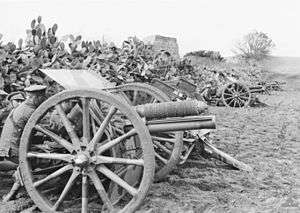 Battery and detachments of the Honourable Artillery Company (HAC) near Belah, Palestine, March 1918 | |
| Type | Light field gun |
| Place of origin | United Kingdom |
| Service history | |
| In service | 1904–1940 (UK) |
| Used by | British Empire |
| Wars | World War I, Easter Rising, World War II |
| Production history | |
| No. built | 416[1] |
| Variants | Mk I, Mk II |
| Specifications | |
| Mass | Barrel & breech 685 lb (311 kg); Total 2,236 lb (1,014 kg)[2] |
| Barrel length | Bore 5 ft 8 in (1.73 m); Total 6 ft (1.8 m)[2] |
| Crew | 9[2] |
| Shell | Fixed QF 76.2 x 313 mm R[3] |
| Shell weight | 12.5 lb (5.7 kg) Shrapnel, later HE |
| Calibre | 3-inch (76.2 mm) L/23 |
| Recoil | Hydro-spring, constant, 41 in (1.0 m)[2] |
| Carriage | Wheeled, pole trail |
| Elevation | -5°to +16°[2] |
| Traverse | 4° L & R[2] |
| Muzzle velocity | 1,675 ft/s (511 m/s)[2] |
| Maximum firing range | 5,900 yd (5,400 m)[1] |
History
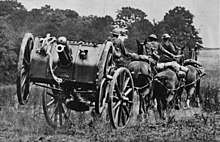
It was developed as a response to combat experience gained in the Boer War and entered service in 1904, replacing the Ehrhard QF 15-pounder and BL 12-pounder 6 cwt. It was intended as a rapid-firing and highly-mobile yet reasonably powerful field gun for Royal Horse Artillery (RHA) batteries supporting Cavalry brigades, which were expected to be engaged in mobile open warfare. It was developed in parallel with the QF 18-pounder used by field artillery.
The original Mk I barrel was wire wound.[2] Later Mk II barrels had a tapered inner A tube[1] which was pressed into the outer tube.
The first British artillery round on the Western Front in World War I was fired by No. 4 gun of E Battery Royal Horse Artillery on 22 August 1914, northeast of Harmignies in Belgium.[4]
It saw action most famously at the Battle of Le Cateau in August 1914 as the British Expeditionary Force retreated from Mons.
It was used to great effect by "L" Bty, Royal Horse Artillery in its famous defensive action on September 1, 1914 at Néry, France, for which 3 Victoria Crosses were awarded. The medals,[5] and No. 6 gun and limber involved in this action,[6][7] are held in the collection of the Imperial War Museum.
From late 1914, when the Western Front settled into trench warfare, the 13-pounder was found to be too light to be truly effective against prepared defensive positions. As a result, a few RHA batteries that were not supporting cavalry formations converted to 18-pounder guns and 4.5-inch howitzers. However, it was retained in the British and Canadian cavalry brigades on the Western Front.[8] and also used throughout the war in batteries (both RHA and Territorial Force) supporting cavalry and mounted formations in Palestine and Mesopotamia.[9]
Batteries normally carried 176 rounds per gun. The gun and its filled limber (24 rounds) weighed 3,368 lb (1,528 kg) and was towed by a 6 horse team. All members of the gun detachments were mounted on their own horses.
As the war progressed, however, the increasing air activity created a requirement for a medium anti-aircraft gun. Some 13-pounders were slightly modified to become "Ordnance QF 13 pdr Mk III" and mounted on high-angle mounts to produce what became known as the 13-pounder 6 cwt anti-aircraft gun.
In 1940, some 13-pounders were brought out of store for use as emergency anti-tank guns, mounted in pill boxes,[10] for the home defence of Britain against possible German invasion.
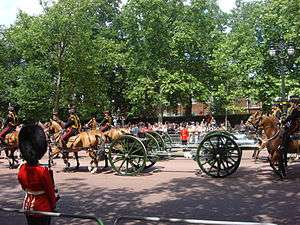
For combat purposes the gun is long obsolete, yet it remains in service with the King's Troop, Royal Horse Artillery for ceremonial purposes and as state saluting guns.[1]
13-pounder 6 cwt QF Mark V naval gun
This was a pedestal-mounted adaptation by Vickers Limited of the Mark I horse artillery gun, intended to arm the Royal Navy's new Motor Launches in World War I. 650 examples were constructed, including 250 made in the United States.[11] Because of the German U-boat campaign, many of the guns were used on defensively equipped merchant ships, some being removed from motor launches for that purpose.[12]
Ammunition
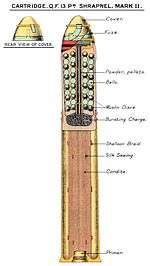 |
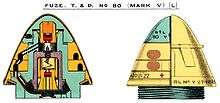 |
 |
.jpg) |
234 balls, 41/lb (90/kg)[2] |
Surviving examples
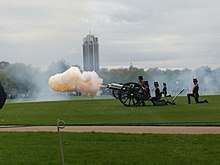
- With the King's Troop, Royal Horse Artillery, London
- Imperial War Museum collection:
- The Néry Gun and limber, used during the action at Néry, 1 September 1914.[6][7]
- No.4 Gun, E Battery Royal Horse Artillery; fired the first British artillery round on the Western Front, August 1914.[14]
- Canadian War Museum, Ottawa
- Fort Seclin – 1914/1918 Museum (Between Ypres and Vimy – Near Fromelles)
- Musee des Abris, Albert, France. (Mk. 2)
- There are 6 examples in South Africa:[lower-alpha 2]
- 1 restored in 2009,
- 1 at THA HQ in Johannesburg,
- 2 with the NFA in Durban,
- 2 at the National Memorial in Potchefstroom.
- Mark V naval gun recovered from a sunken merchant ship, is on display at the harbour in Scarborough, North Yorkshire .
- There is one example on display in the Tsumeb Museum in Namibia. The gun was used by the THA at the Battle of Sandfontein on 26 September 1914 and was captured by German Troops and later dumped into Lake Otjikoto prior to the German surrender in June 1915.
 The Néry Gun, on display at IWM London, April 2008 |
 No 4 Gun E Battery RHA, on display at IWM North, February 2010 |
 13-pounder at the Canadian War Museum |
Popular culture
A QF 13-pounder features in the Big Guns (Dad's Army), where it is supplied to the Warmington-on-Sea platoon for home defence.[15]
See also
- Edward Kinder Bradbury
- George Thomas Dorrell
- David Nelson
- Action at Néry
- List of field guns
- QF 13-pounder 6 cwt AA gun: WWI improvised anti-aircraft version
- QF 13-pounder 9 cwt: later WWI anti-aircraft version (18 pounder gun modified to fire 13 pounder shell with 18-pounder cartridge)
References
Notes
- British artillery denoted guns by the weight of its standard projectile, in this case approximately 13 pounds (5.9 kg), and mortars and howitzers by calibre.
- Pictures available on request, please contact via the 1914–1918 forum : https://www.greatwarforum.org/topic/122427-new-project/
- Clarke 2004
- Hogg & Thurston 1972, page 58
- "77-77 MM CALIBRE CARTRIDGES". www.quarryhs.co.uk. Retrieved 2017-09-05.
- Farndale 1986, page 10
- Imperial War Museum. "Search results for "Néry" [in category 'medals and decorations']". IWM Collections Search. Retrieved 17 April 2013.
- Imperial War Museum (2013). "QF 13 pdr Mk 1 (Nery Gun) (ORD 102)". IWM Collections Search. Retrieved 10 March 2013.
- Imperial War Museum (2013). "Limber for QF 13 pdr Mk 1 (Nery Gun) (ORD 102.2)". IWM Collections Search. Retrieved 10 March 2013.
- Farndale 1986, page 388
- Farndale 1988, page 380
- Cruickshank 2001
- Friedman 2011, p. 112.
- Royal Navy Motor Launches: Armament
- Imperial War Museum (2013). "Round 13 Pdr HE (Sectioned) (MUN 504)". IWM Collections Search. Retrieved 10 March 2013.
- Imperial War Museum (2013). "QF 13 pdr Mk 1 (ORD 101)". IWM Collections Search. Retrieved 10 March 2013.
- Dad's Army "The Big Gun" on YouTube
Sources
- Dale Clarke, British Artillery 1914–1919. Field Army Artillery. Osprey Publishing, Oxford UK, 2004
- Cruickshank, Dan, Invasion – Defending Britain from Attack. Boxtree, 2001 ISBN 0-7522-2029-2
- General Sir Martin Farndale, History of the Royal Regiment of Artillery Western Front 1914–18. Published by Royal Artillery Institution, 1986. ISBN 1-870114-00-0
- General Sir Martin Farndale, History of the Royal Regiment of Artillery, The Forgotten Fronts and the Home Base 1914–18, Published by Royal Artillery Institution, 1988. ISBN 1-870114-05-1
- Friedman, Norman (2011). Naval Weapons of World War One. Seaforth Publishing. ISBN 978-1-84832-100-7.CS1 maint: ref=harv (link)
- I.V. Hogg & L.F. Thurston, British Artillery Weapons & Ammunition 1914–1918. published by Ian Allan, London, 1972.
Further reading
- Extracts from Handbook for the 13-pr Q.F. gun (land service), HMSO, 1908, hdl:10381/107980
- Handbook for the 13 – pr. Q. F. gun, land service, HMSO, 1909, hdl:10381/107943
- 13-pr. Q.F. gun : gun drill, HMSO, 1914, hdl:10381/108016
- Gun drill for 13 pounder Q.F. gun Marks I and II carriage Mark I, HMSO, 1920, hdl:10381/114053
External links
| Wikimedia Commons has media related to QF 13 pounder. |
- The Affair at Néry, 1 September 1914. With map, illustrations and photographs
- Baker, Chris. "The British artillery weapons of 1914–1918". The Long, Long Trail:The British Army in the Great War. Archived from the original on 2007-06-16.